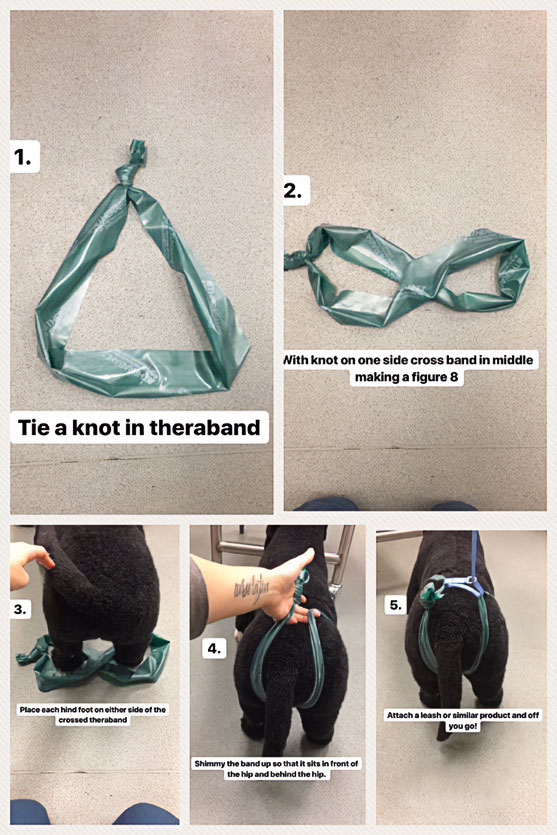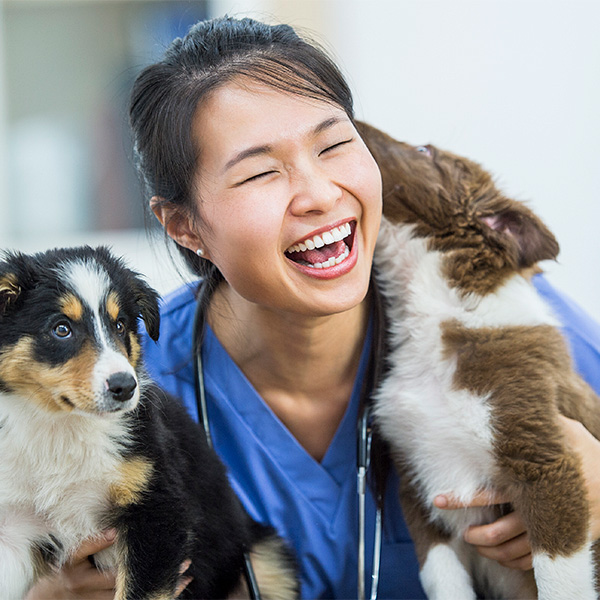Neurological Rehabilitation Exercises for Large Dogs
PROM
Front Legs
Begin with your dog laying on their side, have one hand placed on their elbow to stabilize and the other hand on their carpus (wrist) – slowly bend (flex) the leg & then straighten (extend). If the leg is stiff and resists bending, it may help to flex their toes underneath.
Keeping one hand on the elbow, move the other hand up to the shoulder and guide the leg forward towards their nose. Next, slide the hand down from the shoulder back onto the carpus (wrist) & guide the whole leg back towards the hind leg. Only move within your dog’s comfortable range.
This exercise can be repeated 8 – 10 times per leg, 4 – 6 times per day.
Rear Legs
Begin with your dog laying on their side, place one hand on the front of the stifle (knee) to stabilize the leg, then place your other hand between the tarsus (hock) and their foot, slowly bend (flex) and straighten (extend) the leg. If the leg is stiff and resists bending, it may help to flex their toes.
Next, place one hand along their lower back/pelvis to stabilize their back, then place your other hand above the stifle and slowly extend and flex the hip joint. Only move within your dog’s comfortable range.
This exercise can be repeated 8 – 10 times per leg, 4 – 6 times per day.
Sensory Stimulation
Leg Stimulation
Touch can stimulate nerve endings helping to strengthen neural pathways in the brain & body. This is called sensory stimulation and we can use different methods of touch to stimulate different types of nerve endings.
Methods of sensory stimulation that you can do with your dog are:
- Massage, scratching, tapping, rubbing, stroking, brushing
- Vibration – you can use an old electric toothbrush (with the head attached)
This stimulation should be applied all over the legs that have been affected (front legs and/or back legs).
Toe Stimulation
You can focus on the feet with toe stimulation as this is where the most nerve endings are. Rub and gently pinch between the toes until they move/pull their leg away.
These exercises can be done with your pet in a standing position or frequently (6 – 10 times) throughout the day when lying on their side.
Assisted Standing with Cycling
Rear Legs
If your dog’s back legs are affected, follow the below video.
Assist your dog into a standing position. To simulate a standing position and encourage weight bearing through their back legs, we can ‘block’ their stifles (knees) and prevent the legs from bending. Cross your arms and place your hands above their stifle. You can now gently rock them back, so they have more weight through their back legs- if they take a step with their front legs you need to make the rock more subtle.
Next, pick up one leg bending all the joints and cycle it forwards, dragging the paw along the floor as you move it backwards. If the leg is stiff and resists bending, it may help to flex (bend) their toes. Repeat on the other side.
Repeat 8 – 10 cycles per leg, 4 – 6 times per day.
If more support is required, you can support your dog over an item that allows their feet to touch the ground but takes some of their body weight (shown below). We use an inflatable peanut or partially deflated yoga ball; you could also use step stools or footstool padded with cushions and blankets.

Front Legs
If your dog’s front legs are affected, follow the below video.
Assist your dog into a standing position, supporting them under their chest with your arm. You can now gently rock them to encourage more weight into their front legs. Next, pick up one front leg bending all the joints and cycle it forwards, dragging the paw along the floor as you move it backwards. If the leg is stiff and resists bending, it may help to flex (bend) their toes.
If more support is required, you can support your dog over an item that allows their feet to touch the ground but takes some of their body weight (shown below). We use an inflatable peanut or partially deflated yoga ball, you could also use step stools or footstool padded with cushions and blankets.
Repeat 8 – 10 cycles per leg, 4 – 6 times per day.

Cycling Laying Down
If you are unable to get your dog into an assisted stand, either with the stifle blocking technique shown, or using supportive equipment you can do the cycling and paw drags with them laid down, remember to turn them over to do both sides.
With your dog laying on their side, cycle the leg forwards, dragging the paw along your leg as you move it backwards. If the leg is stiff and resists bending, it may help to flex (bend) the toes.
Assisted Walking
Fit your dog with the Help Em Up harness. Attach a leash to both the front and back parts so you will have support for both ends. Use the front lead to slow them down to a slow walking pace & support their back end enough so that they are in a walking position with the hind feet just touching the ground.
This should be done for short periods: 3 – 5 minutes at a time 4 – 6 times per day, around your home or outside when they go out for bathroom breaks
If not using the above harness, use a supportive front-end harness (check with the neurology team for advice on appropriate harness types) and a Figure 8 TheraBand sling (shown below). Attach a leash to both the harness and sling so you will have support for both ends. Use the front lead to slow them down to a slow walking pace & support their back end enough so that they are in a walking position with the hind feet just touching the ground.
This should be done for short periods: 3 – 5 minutes at a time 4 – 6 times per day, around your home or outside when they go out for bathroom breaks.
Fitting a Figure 8 TheraBand Sling


